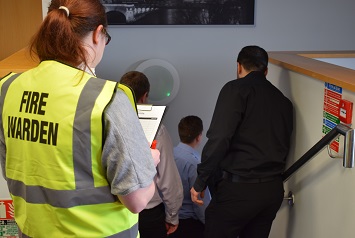
It is essential to ensure that staff are suitably trained on the procedures to be followed in the event of a fire. The Regulatory Reform (Fire Safety) Order 2005 states that the owners or persons in control of non-domestic premises must manage fire safety and in doing so need to provide staff with adequate fire safety training. The training provided is better known as Fire Warden/Fire Marshal Training.
The main role of a Fire Warden is to keep people safe from fire on a day to day basis and bring in to action the emergency plan, should an evacuation be required.
The number of Fire Wardens required is dependent upon a number of factors including the evacuation strategy for the building. As a guide, there needs to be at least one Fire Warden at the fire assembly point and one Fire Warden at each floor level. This number may increase or even decrease depending on the building and its occupants; for example a small office with an open stairwell may not require a fire warden on each floor level.
Other issues that you’ll need to consider are:-
Type of premises
Larger premises take longer to ‘sweep’, there should be a sufficient number of Fire Wardens to check all relevant areas of the building for people and ensure that all areas are evacuated to a place of relative safety within 2 ½ minutes of the alarm being raised/fire being discovered.
If your premises is low risk e.g. an office where the number of people present is relatively low and there is no sleeping risk, it will be relatively straightforward to evacuate (a corresponding relatively low number of Fire Wardens required), however if your premises is high risk e.g. a care home, with not only a sleeping risk but immobile or neurologically impaired people, it will be much more difficult to evacuate (a corresponding high number of Fire Wardens will be required).
How many staff, visitors or customers are there likely to be?
When considering the number of Fire Wardens, you must also consider the number and types of occupants within the building. The type of occupants may include members of the public, disabled people, children, elderly people or sleeping occupants.
If you have high numbers of visitors on your premises who may be unfamiliar with the building, such as within a restaurant or bar, you’ll need a relatively high number of Fire Wardens to direct your visitors/customers to an appropriate exit. A storage warehouse with only a few members of staff who are familiar with the building and its escape routes will only require a low number of Fire Wardens.
Cover for staff holidays or periods of sickness
You must consider that Fire Wardens may not always be on your premises, so the training of your staff needs to be extensive enough to maintain cover at all times, including during periods of staff holidays or sickness.
Who’s going to receive the training?
- When deciding who to train as a Fire Warden, you must consider the following;
- The person responsible for the overall fire safety arrangements, together with key senior members of staff.
- Who’s likely to be in the building at the time of an incident? Choose staff who are predominantly based on the premises rather than those who often work away.
- Don’t choose people who are in a job role with a high turnover of staff or those on a temporary contract.
- If you have weekend or night working, you’ll need cover during these periods.
Summary
The number of Fire Wardens required is based on an assessment of risk, which considers the building type, the use of the building, the numbers and types of occupants.
Posted by: Adrian Gouldin Bsc (Hons) MRICS GIFireE, Marpal’s Head of Fire Safety & IFE registered Fire Risk Assessor.
If you would like to know more about the number of Fire Wardens required or would like information on Fire Warden Training, then please contact Adrian Gouldin at Marpal Ltd (01332) 668877 or [email protected].

